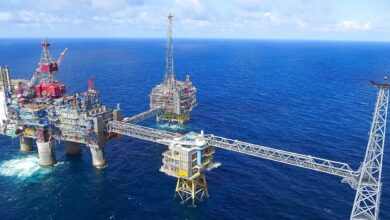Panel session: Performance and drilling can go hand in hand
Representatives from five oil and gas companies – ExxonMobil, Saudi Aramco, PEMEX, Maersk Oil Qatar and Romania’s Petrom – gathered for a panel session at the IADC World Drilling 2010 Conference in Budapest on 17 June to discuss performance drilling. Moderated by Tony Marszalek, president of Schlumberger Italiana, the discussion focused on different strategies to improve performance in a world where “difficult drilling” has almost become the norm. Click below to watch an interview with Marszalek and Drilling Contractor’s Mike Killalea.
First, Stephen Remmert, senior technology adviser for RasGas, a joint venture between ExxonMobil and Qatar Petroleum, advocated the adoption of a physics-based approach to drilling. “From what I’ve seen directly, improving the understanding of drilling-related physics at the rig site reinforces three important aspects of rig work,” Mr Remmert said. They are promoting a more uniform approach to drilling performance across the rig fleet, adding to an already disciplined process at the rig site and enhancing communications to the entire team. “An important byproduct of this enhanced communications is the offshore team can better assist the technical staff in sorting out what new technology should be investigated to improve future performance,” he added.

Historically, ExxonMobil had focused on flawless execution and avoiding nonproductive time in its drilling operations, according to Mr Remmert. But the company came to a realization five years ago. “Overfocus on flawless execution could set very distinct limits on your drilling performance… Should flawless execution become the sole driver of any operation, it becomes increasingly difficult to produce any new technology or practice successfully as it is perceived as a risk to the established routine and it might add to nonproductive time.”
“The best approach is to ground all practices as much as possible into a physics-based description of current performance limits,” he said.
As the company began applying this new approach to the open-hole drilling process five years ago, it took up something called “limit-state thinking,” in which the technical staff attempts to fully describe in advance the current limit state to all major steps in a planned operation, how current practices specifically relate to that limit, and what can be done to extend that limit by altering practices.
Mr Remmert gave this example: “In a directional setting, non-bit limiters might include surface hole motor sliding or rotary steerable control to a predetermined line in a directional plot. This may look to be a best practice to a directional driller. However, we’ve seen that the extra effort to follow a line is not as good as trying to maintain a natural catenary build profile within an acceptable zone, which tends to pay great dividends as one approaches total depth.”
He added: “Another example is overfocus on circulating time to maintain a clean hole. That’s a conservative practice on paper, but how should one really approach the question of how much circulating time is required? … Hole cleaning is not simply about such things as hole geometry, flow rate and fluid rheology. Often, raising the mudweight to preserve hole quality is the better answer. Even if there’s the threat of lost circulation, it’s better to raise fluid density while improving the plan to deal more effectively with losses should they occur.”
Mr Remmert’s company now teaches concepts relating to bit and non-bit limiters and mechanical specific energy to rig personnel “to help them better understand the drilling process, identify the onset of bit dysfunction… And it’s not about greater penetration. Drilling by ROP is an amazingly difficult habit to get rid of at the rig site. It turns out that smooth drilling is a much harder thing to do, and it takes far more patience.”
The second panelist, Khalid Al-Abdulqader, Saudi Aramco manager of the Northern Area Oil Drilling Department, discussed his company’s “never-ending” quest for tools to reach their next target. “We make every effort to attain value and performance with whatever tools are available on the market,” he said.
Saudi Aramco has been working to improve drilling performance through four measurable areas: reducing cost, reducing time, overcoming technical and operational challenges and improving quality.
To reduce cost, the company has implemented three major business models, Mr Al-Abdulqader said. First is project packaging, where all services on a project are tendered to a single provider. This could range from a small number of wells to hundreds of wells in a project. When using this model, he said, it’s important to have a multidisciplinary focus team assigned to the field that can provide its expertise to all rigs on a 24/7 basis.
As an extension of the project packaging model, Saudi Aramco recently embarked on a pilot “lump sum turnkey” project. “So far we’re doing pretty good,” he said.
The third model has been to use multilaterals and extended-reach drilling to deliver maximum reservoir contact, with the objective of reducing the number of wells and surface facilities.
To reduce time, the company has taken to accelerating the adoption of new technologies. “So far we have been successful by introducing rotary steerable systems and partnering in developing NMR tools for better placement of our wells.” The latter refers to the nuclear magnetic resonance (NMR) LWD tool that Saudi Aramco developed in conjunction with a service company.
Processes such as benchmarking and KPIs also are used to reduce time, and they are continually updated with new field data.
On overcoming technical and operational challenges, Mr Al-Abdulqader pointed specifically to the task of re-entering deep gas wells to drill sidetracks in order to maintain productivity. “Normally we do this by workover rig. However, the results that we had been getting were not really encouraging in terms of production rate. By introducing underbalanced coil-tubing technique, we were able to overcome that challenge,” he said. In fact, the company has been able to triple its production rate in those wells by eliminating formation damage.
On the final focus area of improving quality, the company continues to establish engineering and operation standards, conduct R&D and conduct pre-qualification and trial tests for all service providers.
The next panelist was PEMEX’s manager of engineering and design for the southern region, Carlos Perez Tellez. He noted that some of the biggest challenges at his company related to drilling performance involve extended-reach wells, HPHT wells, deepwater wells, low-pressure reservoirs and geological complexity.
To overcome these challenges, new technologies have been adopted, some more frequently than others. The more commonly used technologies include horizontal drilling, LWD, foamed water-based mud, MPD and rotary steerables. Technologies that are just emerging and still require adjustment before they can be implemented in Mexico, he said, include expandable casing, rig automation and coiled-tubing drilling.
“Our future extended-reach wells will demand a technology that will allow us to go deeper, and for doing that we require tools that will allow us to enlarge the Mesozoic formations,” he said, calling for better reaming-while-drilling tools. HPHT tools, well placement tools, expandable casing, personnel expertise and rig capacity were cited as other concerns when it comes to extended-reach wells in Mexico.
In deepwater, Dr Tellez noted that PEMEX must drill wells in water depths of 3,000 m or greater and begin production by 2015. “To do that, we really require the help of all the world. The experience that the world has is welcome to Mexico,” he said.
Leo Maekiaho, head of drilling for Romania’s Petrom, began his presentation by noting that his challenges would be quite different from the other panelists because drilling in Romania “is not doing so great.”
Currently, approximately 150 wells are being drilled in that country each year, with an average well depth of 1,500 m. There are 50 registered rigs in Romania and 25 actively drilling, plus more than 300 workover rigs/hoists. “We have around 8,000 active wells that need to be worked over frequently, and that’s a massive operation,” Mr Maekiaho said.
In order to achieve performance drilling in Romania, he said, “we need to change.”
First, the country must modernize. “I would say 50 years under a Communist regime did not help Romania to follow the rest of the world in development. It was standing still for quite some time. That’s why our biggest job in Romania is to catch up where we lost a lot,” he said.
Other steps that Mr Maekiaho believes should be taken include reinstating Romanian drilling schools, promoting stronger IADC and SPE communities and supporting government authorities in modernizing national standards. Introducing API/ISO standards is another must, though it will take great effort. “For instance, you go to look for a company to inspect and certify your equipment – don’t have it,” he said.
It is possible to improve the situation in Romania, he continued, but the resistance to change must be overcome and bureaucracy must be reduced.
“One thing we have to do in Romania is change the way we organize drilling activities. In the past, we allocated wells to drilling contractors just based on our need for drilling. If there was no drilling, they stay home. If you need to drill a well, you call them, ‘OK, mobilize, drill a well,’ ” he said. “The average utilization of those rigs capable of drilling in Romania landed around 30% to 40%. If you only make money 30% to 40% of the time, how can you survive?”
Mr Maekiaho said his “best hope” for change now lies with young people, and he has hired 35 graduates from the University of Oil & Gas in Ploiesti over the past three years.
And proving that things can change for the better “if everything is lined up correctly,” a Romanian drilling record was recently set using a Nabors rig with a Romanian crew: 1,112 m of a 12 1/4-in. hole was drilled in just 24 hours. “It’s by no means a world record,” he said, “but it’s a hell of a lot better than taking, say, one month to drill a section.”
The final panelist of the session was Peter Vilhelm Balslev, Maersk Oil Qatar, head of the drilling engineering group. This is the group that set a world record in May 2008 with well BG-04-A in the Al-Shaheen field offshore Qatar, with a total length of 40,320-ft MDRT.
In discussing the challenges his group faced when starting the Qatar field development plan in 2006, he noted that stick-slip became a major issue. “Stick-slip is not understood in the industry. Nobody has been able to mathematically model it or predict it, and it has a huge impact on our tool reliability.”
Other challenges faced were losses drilling through fractures, accurate wellbore positioning and sustained casing pressure. Some of the solutions the group came up with included redesigning the BHA and drillstring configuration, materials, geometry and hardbanding. “We cannot solve the stick-slip issue. We are monitoring it real-time, and we can manage it,” Mr Balslev said.
He added that losses while drilling through fractures has been minimized to a level where drilling can continue to TD. The team also stopped using horizontal pump-down gyro surveys and turned to enhanced MWD services. “We have built our own very accurate mathematical models,” he said.
As a result of these efforts, the group is now able to drill 30,000-plus ft wells in one run to TD, compared with having up to five BHA runs in the early part of the project.
“I would say drilling performance is not an oxymoron as long as we’re focused on delivering better wells and not faster and cheaper wells,” he said.
Click below to watch an interview with Schlumberger Italiana president Tony Marszalek and Drilling Contractor’s Mike Killalea.




